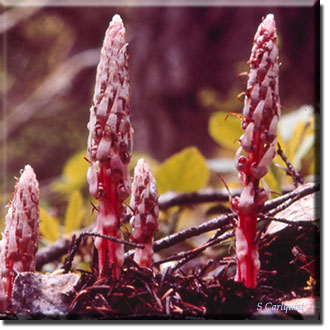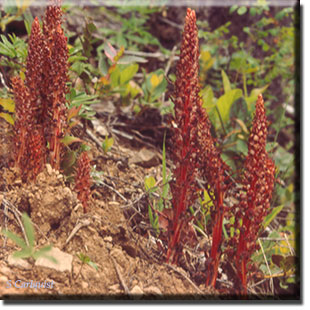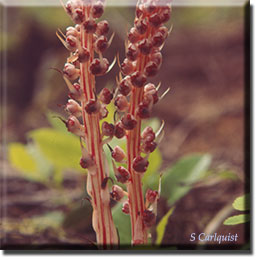 Allotropa virgata, the sugar stick, is a parasitic plant related to the Indian Pipe, the Snow Plant, and the other species in the subfamily Monotropoideae of the heath family, Ericaceae. Like the others, Allotropa is parasitic on fungi that occur in leaf litter beneath conifers. Allotropa is found beneath pines and firs in the Sierra Nevada and northern Coast Ranges of California, and it extends northward to the Cascade Range of Oregon and the Olympic Range of Washington. The plants in this photograph are young, and only a few of the many flowers have opened at this point.
Allotropa virgata, the sugar stick, is a parasitic plant related to the Indian Pipe, the Snow Plant, and the other species in the subfamily Monotropoideae of the heath family, Ericaceae. Like the others, Allotropa is parasitic on fungi that occur in leaf litter beneath conifers. Allotropa is found beneath pines and firs in the Sierra Nevada and northern Coast Ranges of California, and it extends northward to the Cascade Range of Oregon and the Olympic Range of Washington. The plants in this photograph are young, and only a few of the many flowers have opened at this point.

Most of the flowers are open on these plants of Allotropa. The flowers turn upward or outward, and that accounts for the name Allotropa, which in Greek means "turned differently." The flowers of the other monotropoids, such as Indian Pipe or the Snow Plant, point downwards.
This picture shows the red and white stripes of the Sugar Stick plant clearly. One authors says that the plants are red with white stripes. But aren't they really white with red stripes? The leaves of the plant are white, which suggests that perhaps the plant is basically white.
The flowers of Allotropa are white but turn brown quickly. Each flower has five sepals, but no petals. That's why you see the reddish stamens so prominently here. The tips of the stamens point toward the center of the flower.
In these Allotropa flowers, the sepals are still white. The stamens are bright red, and the stigmas, in the center of the flower, are very dark red and shiny.

The fruits of the Sugar Stick, Allotropa, are rounded and crowded on the stem. The fruits are dry and papery at maturity, and the tiny seeds fall out through the slits on the sides of the fruits.